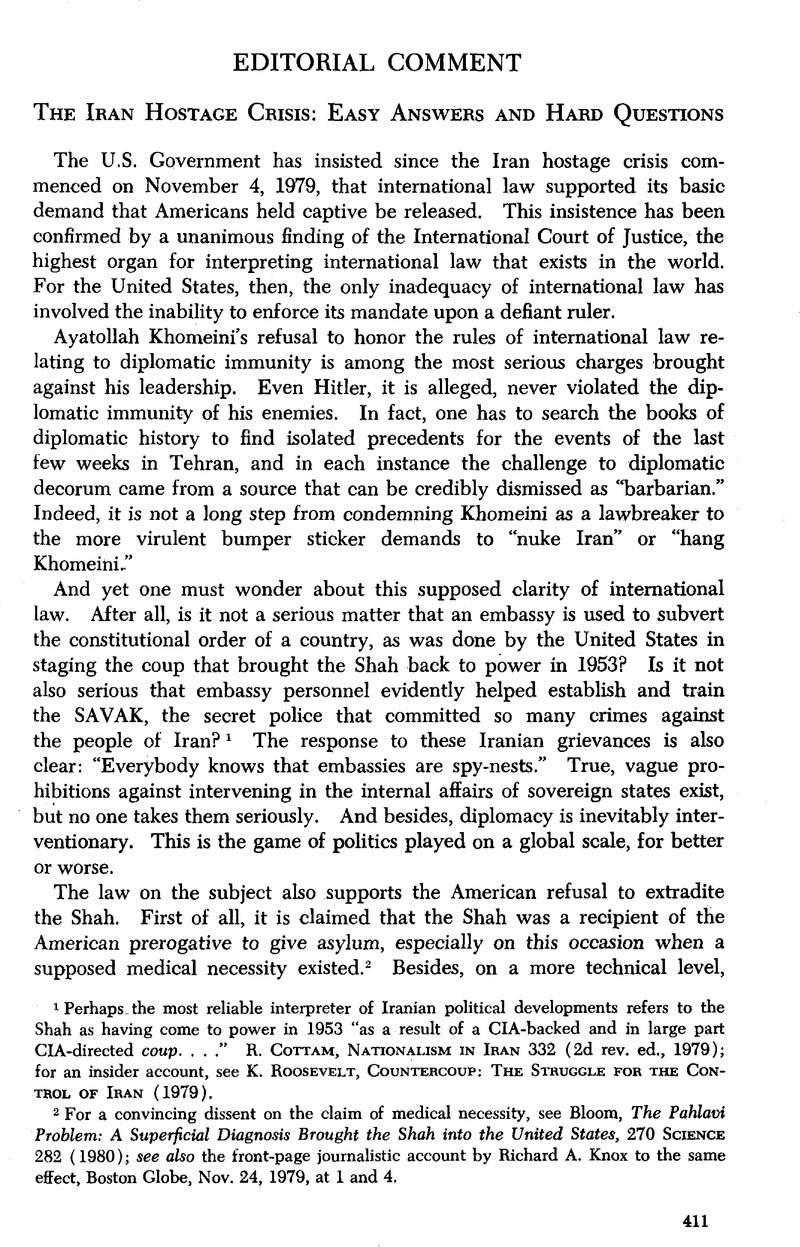Article contents
The Iran Hostage Crisis: Easy Answers and Hard Questions
Published online by Cambridge University Press: 27 February 2017
Abstract

- Type
- Editorial Comment
- Information
- Copyright
- Copyright © American Society of International Law 1980
References
1 Perhaps the most reliable interpreter of Iranian political developments refers to the Shah as having come to power in 1953 “as a result of a CIA-backed and in large part CIA-directed coup… .”R. Cottam, Nationalism in Iran 332 (2d rev. ed., 1979); for an insider account, see K. Roosevelt, Countercoup: the Struggle for the Control of Iran (1979).
2 For a convincing dissent on the claim of medical necessity, see Bloom, , The Pahlavi Problem: A Superficial Diagnosis Brought the Shah into the United States, 270 Science 282 (1980)CrossRefGoogle Scholar; see also the front-page journalistic account by Richard A. Knox to the same effect, Boston Globe, Nov. 24, 1979, at 1 and 4.
3 According to U.S. law, extradition cannot be granted by the President apart from a treaty, unless authorized by legislation. Even if a special statute authorizing extradition of the Shah had been validly enacted, it would almost certainly have been struck down by the courts as an ex post facto law. For a brief summary of the legal situation pertaining to extradition in the absence of a treaty, see M. Whiteman, 6 Digest of International Law 732-37 (1968); compareValentine v. United States ex rel. Neidecker, 299 U.S. 5, esp. 8-9 (1936).
4 An excellent analysis of the dependence of international order upon upholding the norm of nonintervention as much as possible is to be found in R. Vincent, Nonintervention and International Order (1974).
5 Interview with Ayatollah Khomeini, Time, Jan. 7, 1980, at 27.
6 Acheson, Remarksin ASIL, 57 Proceedings 13, 14 (1963).
7 For a skeptical assessment of the relevance of international law to the Cuban missile crisis, see Gerberding, , International Law and the Cuban Missile Crisis, in International Law and Political Crisis 175-210 (Scheinman, & Wilkinson, eds., 1968)Google Scholar. Comparethe much more positive view in A. Chayes, the Cuban Missile Crisis (1974).
8 Meeker, , The Dominican Situation in the Perspective of International Law, 53 Dep't State Bull. 60, 60 (1965)Google Scholar.
9 The results of this investigation remain impressive as a moral and legal indictment of U.S. tactics in the Vietnam War. SeeAgainst the Crime Op Silence: Proceedings of the International War Crimes Tribunal (Duffett ed., 1970).
10 For the text of the declaration, see UN Law/Fundamental Rights 219-23 (ed. Cassese, 1979).
11 My thoughts on these matters are developed further in The Algiers Declaration of the Rights of Peoples and the Struggle for Human Rights,in id.at 225-35, and Keeping Nuremberg Alive,in Homage to Lelio Basso 811-20 (Amato et al., eds., 1979).
- 6
- Cited by




